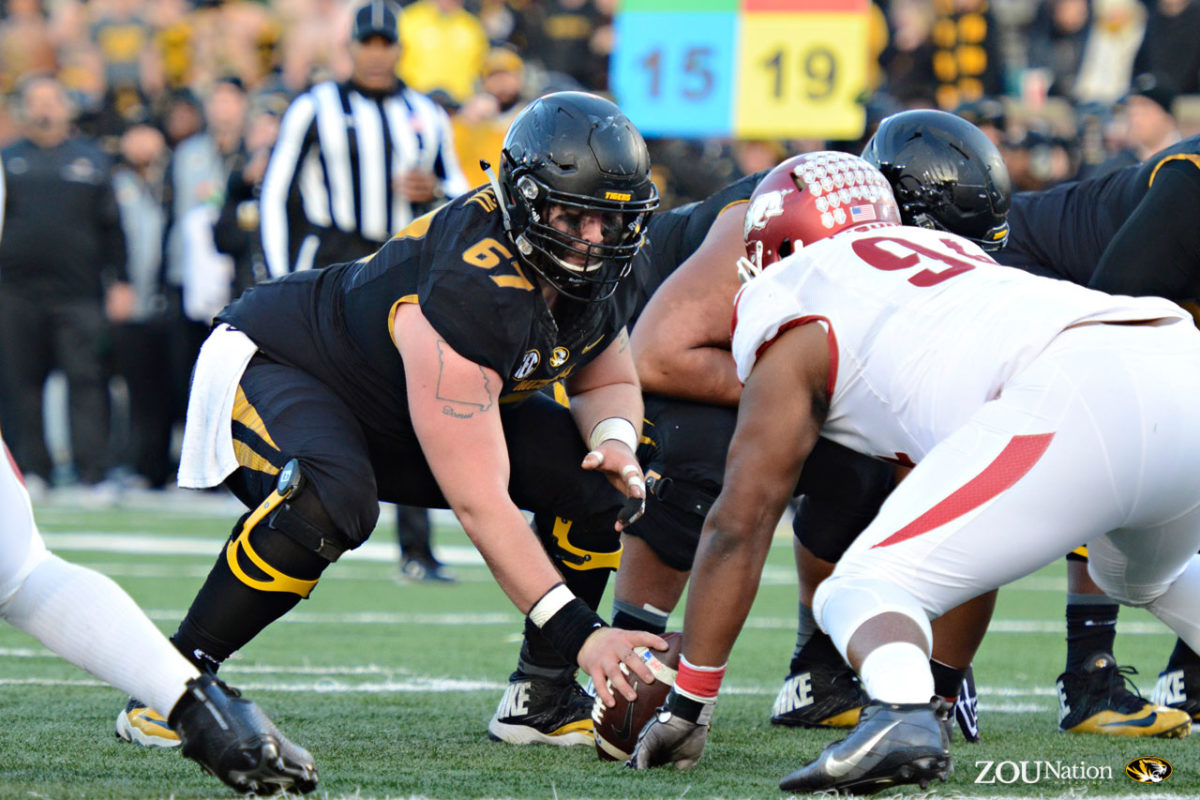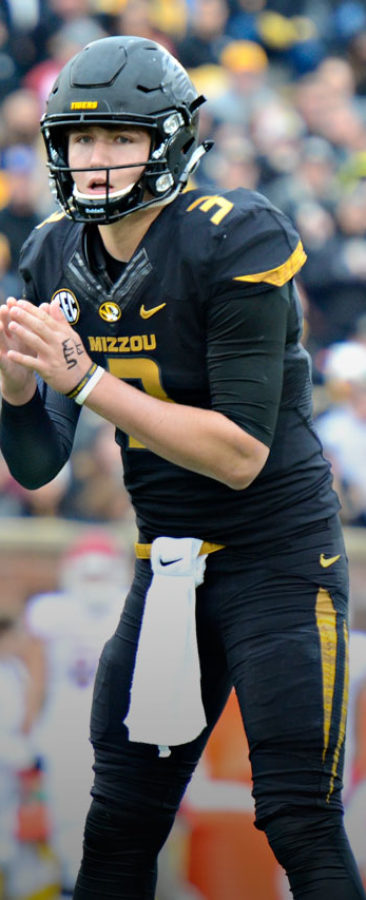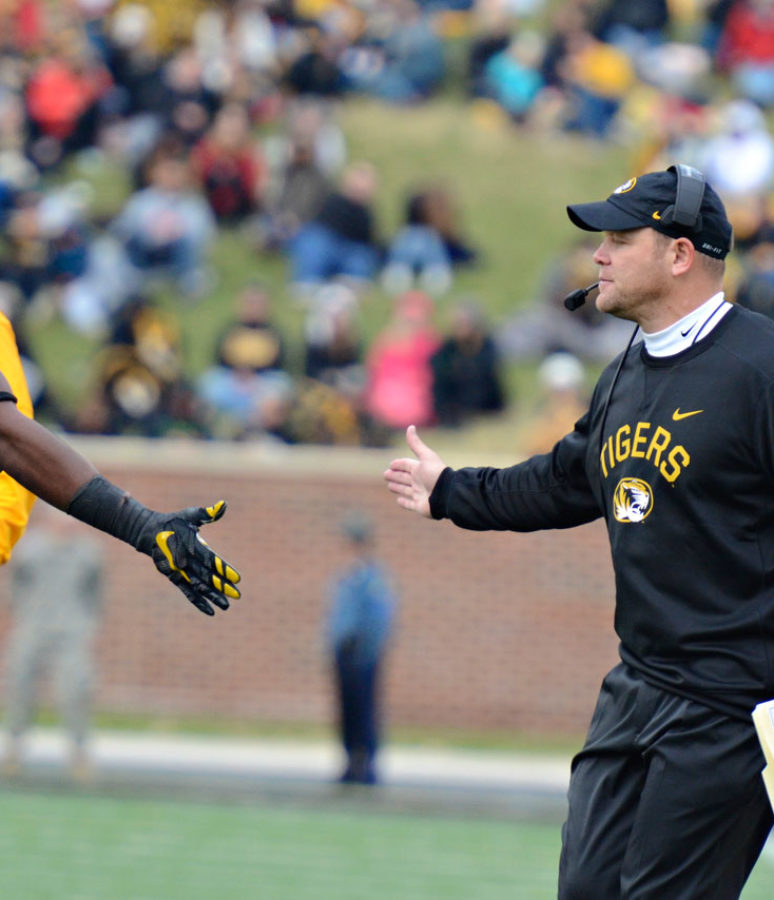Forward Progress
Missouri wrapped its season without a bowl bid for the second straight year, but with 10 returning starters and an offense that notched 500.5 yards per game, there’s no time to sleep on its potential.
Now what?
What are the expectations in 2017 for a 4-8 Missouri football team who showed so much promise yet at times couldn’t get out of its own way? Can an offense that led the Southeastern Conference in total yards take the next step as it returns 10 starters? Or will it again be plagued by untimely drops from a talented yet inconsistent receiving corps? Can the Tigers fix the defensive issues that troubled them for most of the year? Or will Mizzou struggle once again to stop the run? And how will head coach Barry Odom and his staff benefit from his first full year of experience?
So many questions. So much anticipation.
“I expect we’ll see a team playing with a lot more pride and a lot more fight; a team that will understand what its identity is,” says Howard Richards, the Mizzou football radio analyst turned Assistant Athletic Director for Community Relations. “They didn’t have an identity last year. Over the offseason, they will build that identity, build on that brand of who they are.”
No doubt there is plenty to build upon, especially when you consider what the offense accomplished in 2016. Although their numbers were skewed by lopsided wins over Eastern Michigan and Delaware State, the Tigers still racked up 500.5 yards per game. They were second in the SEC in passing yards, with 295.4 yards per game, and a respectable eighth in rushing. Most remarkable is that these numbers came just one year after Mizzou ranked last in the conference in total passing and rushing yards, as well as points scored. The most encouraging prospect: There’s plenty of room for improvement, particularly from quarterback Drew Lock and his receivers. Everything revolves around Lock, who will begin his third year under center and his second season directing coordinator Josh Heupel’s no-huddle attack.
“When he’s on, there’s not a better quarterback in the conference,” says former Missouri wide receiver T.J. Moe, who in four seasons caught 188 passes with12 touchdowns.
The issue, however, is that even as Lock threw for 23 touchdowns and 3,399 yards — the fifth most in program history — he was plagued by inconsistency. For all of his gaudy statistics, Moe says, Lock never put together a full half, much less a complete game. Consider: He lit up Georgia for 376 passing yards, but threw three second-half interceptions in a gut-wrenching one-point loss. In the midst of a defensive struggle against Florida, he threw a pair of pick-sixes late in the first half, and the game devolved into a rout. At Tennessee, Mizzou piled up 740 yards but played uphill the entire second half after Lock threw an interception on the first snap of the third quarter that set up the Vols on a short field.
“Having been a receiver, I look at the quarterback a little differently,” Moe says. “It’s not necessarily the production just yet, and it’s not necessarily how he looks doing it. It’s the velocity with which he can deliver the football and the touch he can put on it.
“If you can get his mechanics to be consistent and get repetition this off-season, with that potential you’re absolutely looking at an all-conference talent. Generally, when you’ve got an all-conference talent at quarterback, you’re competing for championships.”
Odom, for one, is bullish on Lock. During a December appearance on KFNS radio in St. Louis, at Moe’s behest, the coach played word association on a handful of players. When Moe threw out Lock’s name, without hesitation Odom said, “Competitor. Super talented. Will lead us to a championship.”
No pressure there, kid. Some would argue that’s an unreasonable expectation to place on a career 52.5 percent passer who is 6-14 as a starter. But the comment speaks volumes about Lock’s tremendous potential, as well as the largely untapped talent with which Odom and Heupel have surrounded their quarterback.
In 11 games, including three in which he had only 16 combined carries, true freshman Damarea Crockett ran for 1,062 yards, averaged 6.9 yards per carry and scored 10 touchdowns. Yet while Crockett, one of several of Odom’s 11th-hour recruiting coups, was a pleasant surprise, he wasn’t the biggest one. That honor was bestowed upon a retooled offensive line, which went from being Mizzou’s most glaring weakness in 2015 to arguably its greatest strength. New offensive line coach Glen Elarbee was quite simply a miracle worker. Plugging in four new starters, the Tigers were first in the country in tackles for loss allowed, with 35, and led the SEC in fewest sacks allowed, with 13.
Richards knows a thing or two about offensive-line technique. He started 40 consecutive games at right tackle for Missouri from 1977-90, and was the first-round draft pick of the Dallas Cowboys in 1981. “Because of the line play, the quarterback play was elevated,” Richards says. “Drew Lock has his critics, but just look at what he has been able to accomplish. That was a direct reflection of how the offensive line played.”
As he continues to develop and become more comfortable in the offense, Lock could use a little help from his friends. The wideouts in 2015 were an enigmatic bunch, capable of delivering a highlight-reel reception, yet also prone to the untimely, inexcusable drop. Moe minces no words.
“Probably every receiver on that roster is more athletic than I was, but most of them have been about half as productive,” he says. “It’s a lack of concentration. Perhaps it’s a lack of work ethic, a lack of preparation. How many times did J’Mon Moore fumble after making a great catch? And how many times was there a big drop down the sideline when you had your man beat by three yards and you would have had a walk-in touchdown?” Moe asks. “There are little things that should have been gimmes that changed the whole outlook of the season. Instead, we look at the group and say, ‘Gosh darn, they’re inconsistent.’
“That group can be really good” he says. “These guys can run by you. They just need to hammer down this offseason and get to it.”
Adds Richards, “If you had probably half the drops back, you’re looking at two more wins. And not just the wins. They’ll roll off more plays. They’ll control the clock.”
Ah, the clock. Missouri was 128th in the country — dead last — in time of possession, at 24:18. (Amazingly, despite the limited time on the field, the offense played so fast that it ran only two fewer players than its opponents: 948 versus 950.) The dangers with any hurry-up attack are the short possessions and the multiple three-and-outs — your defense is repeatedly exposed, no matter how good it might be. And in 2016, Mizzou’s defense was, in two words, exposed and bad. The Tigers were last in the SEC and 118th in the country in total defense. They were 13th and 112th against the run and 12th and 86th against the pass. Considering Odom’s background and the recent success Missouri had enjoyed on that side of the ball, the defensive struggles
were as shocking as the offensive-line play was a surprise.
In 2015, when Odom served as defensive coordinator, the Tigers were sixth in the country in total defense, even with an offense that ranked 124th in total yards and 116th in time of possession (27:02). Although several key players departed — most notably all-SEC linebacker Kentrell Brothers — Odom and new coordinator DeMontie Cross had the foundation upon which to build a strong unit. The issue came when Odom scrapped the attack scheme for a read-and-react system.
West Virginia piled up 494 yards. LSU gashed the Tigers for 634 yards, including 418 on the ground. Even Middle Tennessee State moved up and down the field at will, with 311 yards rushing and another 284 yards passing. Odom took over play-calling duties from Cross, and finally went back to the attack scheme that called for players to tackle the ball carrier on their way to the quarterback. But the damage had been done. As Moe notes, while most defenders knew the old scheme, first-year players had to learn an unfamiliar system on the fly. A year after giving up an average of 302 yards per game, the Tigers gave up 400 yards or more to all 11 of their FBS opponents.
“I imagine there was difficulty buying in,” Richards says. “There were issues with responsibilities and players alluding to having to think too much. The simpler it is, the easier it is to play. You have less to absorb. It’s easier to do than when you have a billion things to remember.”
So why will 2017 be any different? For one, Odom has a year under his belt and a coaching staff and a system in place. The player boycott of 2015 is a distant memory. Players better understand what the expectations are. There is the opportunity to build on victories in the final third of the season over Vanderbilt and Arkansas; the defense was salty in the second half of each of those games, and the Tigers rallied from a 24-7 halftime deficit against the Razorbacks. In any event, Richards and Moe agree that Odom is the man for the job.
“The testament to Barry’s character and abilities as a coach was shown when he was introduced as the head coach,” Richards says. “The way those players responded to him, they knew what he meant to them as a football coach. Barry’s the right guy. He has the temperament. He has the youth and the desire to turn this program around. As a player, you have to understand what your coach is trying to teach you. If you aren’t able to push aside the distractions and focus on that particular task, you can’t be successful.”
As someone who played at Mizzou when Odom was an assistant, Moe has seen it all first-hand. He is among Odom’s biggest fans. “Coach Odom has a warm personality toward his players and gets to know you and cares about you,” Moe says. “And he doesn’t have this huge barrier: I’m the head coach, the king, the dictator. That’s not the relationship he has with the guys. But don’t get me wrong: He has a strong personality, and when he talks, you listen.”
Perhaps Odom’s biggest accomplishment as a rookie head coach was holding the locker room together as Missouri struggled through a five-game skid. With road contests against West Virginia, LSU and Florida and an SEC home opener against Georgia in the first half of the season, the schedule-makers didn’t do the Tigers any favors. When it was mentioned during an October interview that better days were ahead and that hopefully he was at least enjoying the ride, Odom replied matter-of-factly, “We just need to win some games.”
Better days are ahead, and with a run of four consecutive home games to open the 2017 season — against Missouri State, South Carolina, Purdue and Auburn — the upcoming September schedule is every bit as kind as the 2016 early slate was brutal. It serves as an opportunity to build some real momentum. A bowl invitation is expected, but should fans expect more?
Richards recalls a recent conversation with former Mizzou teammate Kellen Winslow, the Pro Football Hall of Fame tight end. Winslow noted that there was one thing missing on the Tigers’ schedule. “You know what it is?” Richards recalls Winslow saying. “They don’t have the SEC championship game on there. That should be the goal.”
No question.
Mark Godich is a senior editor at Sports Illustrated and the author of the 2013 book, Tigers vs Jayhawks: From the Civil War to the Battle for No. 1.



